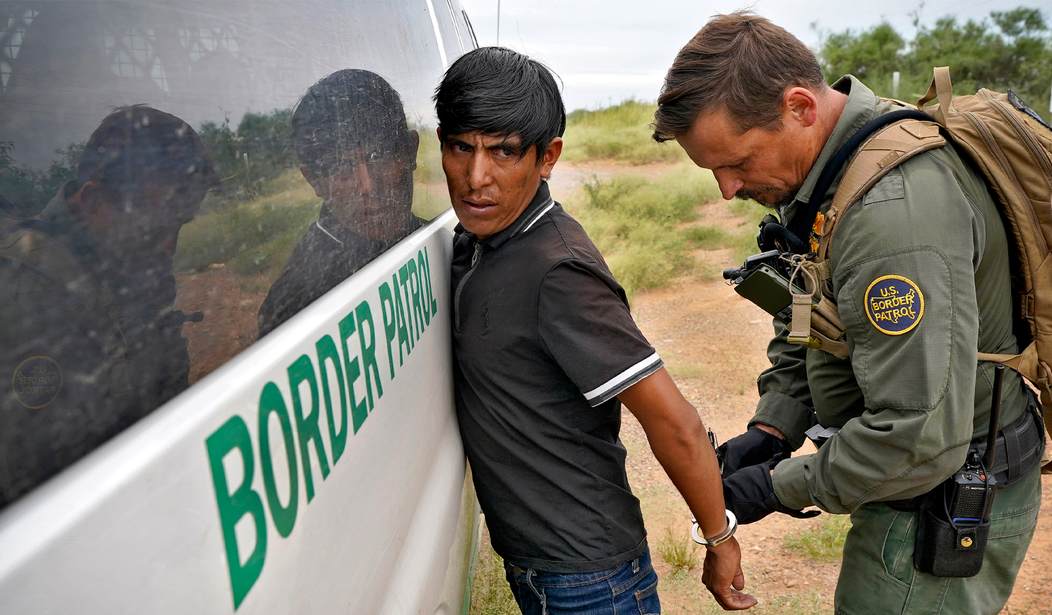If you're plugged into the chaotic, ever-packed news cycle, you've likely heard Title 42 being mentioned between the madness. You might know it's set to expire this week and that its lifting will ignite major ramifications at the United States-Mexico border.
As we're a day away, here's all you need to know ahead of Title 42's expected expiration, how its end will gravely impact America's already embattled southern border, and how the Biden administration is responding in comparison to state-level action.
What's Title 42?
Title 42 is a pandemic-era public health order invoked under the former Trump administration that authorized U.S. Border Patrol agents to swiftly expel illegal immigrants on grounds that the would-be entrants might carry COVID-19 into America. The policy—deriving from Title 42 of the U.S. legal code, the federal body of public-health legislation—was intended to prevent the spread of the coronavirus throughout illegal immigrant-detention facilities, and it's been used since as an immigration regulation-and-management tool.
When the U.S. Centers for Disease Control and Prevention (CDC)'s temporary Title 42 restrictions lift at 11:59 p.m. on May 11, also the death-date for a pair of national COVID-19 emergency declarations, the U.S. will return to time-consuming processing and removing of illegal aliens under Title 8 rules, in accordance with the section of the U.S. code pertaining to immigration law.
What Happens When It Ends?
Title 42's anticipated termination will spur an onslaught of treacherous trips to America, more than ever before, as U.S. immigration authorities brace for an all-time border rush. Going from the immediate expulsion of illegal immigrants by the millions, the post-Title 42 scene down south could, instead, see border stations overwhelmed by the sheer volume of entries and nearby communities flooded by a wave of illegal border-crossers trekking to neighboring border towns upon release from custody.
Recommended
BREAKING: Video from journalist @BensmanTodd shows @TxDPS troopers and TX National Guard soldiers physically repelling/blocking migrants who are crossing the river illegally into Brownsville, TX. They have also deployed razor wire via orders from TX Gov. @GregAbbott_TX pic.twitter.com/o7nvtBbKlh
— Bill Melugin (@BillFOXLA) May 10, 2023
Estimations are in the tens of thousands. Troy Miller, the top official at the U.S. Customs and Border Protection, told Congress that his agency is estimating as many as 10,000 illegal immigrants crossing the border, without authorization, each day after Title 42 sunsets, which would almost double the daily average in March. Other data based on DHS-encounter projections suggest that illegal arrivals could rise to 11,000 - 13,000 per day. The federal government estimates that more than 150,000 illegal immigrants are amassing in shelters and on the streets of northern Mexican states bordering the U.S. awaiting Title 42's end, according to CNN.
U.S. Border Patrol apprehended 10,300-plus illegal immigrants who crossed unlawfully Tuesday, and Monday also broke the 10,000-threshold—deemed the highest single-day totals ever recorded and counting, CBP sources told Fox News reporter Bill Melugin.
The president of Guatemala told Texas Rep. Tony Gonzales he knows of at least 80,000 "predominantly Venezuelan nationals" en route to the U.S. border before Title 42's drop and "that nobody at the White House would take his calls," Melugin reported.
Over in Matamoros, Mexico, troves of illegal immigrants are heading this way, come hell or high water, literally.
Matamoros Mexico, where everyone heartfeltedly believes @SecMayorkas many public assurances that “the border is closed”
— Todd Bensman (@BensmanTodd) May 9, 2023
And “the border is secure” pic.twitter.com/DJlhLDv7nm
Meanwhile, hundreds of illegal immigrants are already attempting to evade law enforcement to reach downtown El Paso, Texas, as Julio is extensively covering with on-the-ground reporting from inside the massive illegal immigrant-turned-"refugee" camp there.
The conditions people are camping out in El Paso are very poor. Because the sidewalks are full by the church, others are in alleyways. All of this is before Title 42 is officially gone.https://t.co/nIKV8V2cj7 pic.twitter.com/2D21zaJofe
— Julio Rosas (@Julio_Rosas11) May 6, 2023
How's Biden Responding?
Preparations are underway on the federal front with the U.S. Department of Defense declaring at the Pentagon last week that it will deploy another 1,500 active-duty troops to the border to offer operational support and relieve some of the strain on U.S. Border Patrol by helping agents with administrative tasks, such as transportation, data-entry, and warehouse assistance.
The U.S. service members, arriving by May 10 and dispatched from Army and Marine units, will be deployed for 90 days but are not assigned to take on any law enforcement duties like detaining or processing illegal immigrants. Instead, the military units will play a supportive role only, as military personnel "have never, and will not, perform law enforcement activities or interact with migrants," DHS stressed. A federal law dating back to 1878, in general, prohibits the military from conducting civilian law enforcement.
In a new statement, DHS reiterates that military "personnel have never, and will not, perform law enforcement activities or interact with migrants."
— Camilo Montoya-Galvez (@camiloreports) May 2, 2023
"DoD personnel will be performing ... ground based detection and monitoring, data entry, and warehouse support." pic.twitter.com/t3K92DXSPh
About 2,500 National Guard troops are already on active-duty orders at the border to bolster CBP's efforts.
At the end of April, the U.S. Department of Homeland Security and the U.S. State Department issued an April 27 fact sheet announcing that the Biden administration will be implementing "sweeping new measures to further reduce unlawful migration across the Western Hemisphere..." (The laughable keyword is "further," implying that there has somehow been a reduction of illegal border crossings thus far, given that under the current commander-in-chief's watch, President Joe Biden's administration continues to let record levels of illegal aliens loose into the U.S. and has failed to capture a jaw-dropping number of gotaways.)
We have been preparing for the end of the use of Title 42 for more than a year-and-a-half. Read about our latest efforts to build lawful pathways for migration and to impose consequences for failure to use those pathways: https://t.co/kORpboZMp9 pic.twitter.com/yr0blfcDbN
— Homeland Security (@DHSgov) April 27, 2023
Immigration watchdogs, of course, have pointed out that the Biden admin's supposed post-Title 42 plan is deeply flawed by design, as Townhall previously deconstructed, and that the "new" steps being taken are rehashes of old actions, but beefed up.
Some experts, who assess the rollout as nothing more than a regurgitation of "the same failed policies [...] only on steroids," are saying that the master plan, which self-admittedly is billed as "managing" Biden's border crisis, will simply "accommodate" the looming deluge of illegal immigration—rathan than prevent or deter it. And that, evidently, is how we've ended up where we are.
How Are the States Responding?
Texas Gov. Greg Abbott announced Monday the deployment of the Texas Tactical Border Force, the third phase of Abott's plan, sending hundreds of specially trained Texas National Guard soldiers to join the thousands already deployed as part of Operation Lone Star and serve on the new unit for targeted responses to hotspots along the border. "With the ending of Title 42 on Thursday, President Biden is laying down the welcome mat to people across the entire world..." Abbott stated in a press release.
Texas is responding to the chaos caused by Biden ending Title 42.
— Greg Abbott (@GregAbbott_TX) May 8, 2023
The new Texas Tactical Border Force will help intercept & repel migrants trying to enter Texas illegally.
Biden sent 1,500 troops to the border to do paperwork.
I deployed elite trained soldiers to defend Texas. pic.twitter.com/Jifj8LaqPW
Last month, the first phase of Abott's multi-phase response began with the shifting of the state's National Guard soldiers and assets, such as drone teams and razor wire barriers, and on Sunday, a second phase was then implemented, deploying two quick-reaction forces composed of military police units, one in El Paso and another from San Antonio to the Rio Grande Valley.
At a Monday press conference, Arizona Gov. Katie Hobbs also addressed the Grand Canyon State's five-point "preparedness" approach. Under the plan, the amount of Arizona Department of Public Safety troopers will be increased at the border to further assist U.S. Border Patrol officers; the state will be coordinating the transportation of illegal immigrants out of Arizona, meaning bussing them to different locations; Hobbs' office will establish a joint-information command to share updates across agencies; and the state's Department of Emergency Management will coordinate emergency shelter for the illegal immigrants who await departure.
1. Public Safety- I have directed the Arizona Department of Public Safety to assist local sheriffs and law enforcement in maintaining safety and security on Arizona highways and prevent harmful drugs like fentanyl from being brought into our state. 2/7
— Governor Katie Hobbs (@GovernorHobbs) May 9, 2023
However, Hobbs said she is hoping the Biden administration will step up to help out Arizona with funding, but so far, the state has not received the necessary aid from federal officials. "I've sent letters to President Biden and Secretary Mayorkas outlining specific actions that need to be taken. As of today, we have not received an adequate response," Hobbs said, adding: "We will continue to relentlessly pressure the federal government until we truly get the resources we need to manage the expected influx."
New Mexico hasn't made any moves as of yet. The state's National Guard has "not been tasked" by Gov. Michelle Lujan Grisham "for any mission at the border," the force told KOAT-TV in a press statement when the local Albuquerque-based outlet inquired.

























Join the conversation as a VIP Member